Found a total of 10000 related content

how to insert page number in excel
Article Introduction:This article explains how to insert and customize page numbers in Excel. It details accessing page setup, using header/footer tools to add page numbers, and formatting options including style, font, alignment, and location within the header or foote
2025-03-12
comment 0
1092

Enable a Page Turning Effect on Books for iPhone & iPad
Article Introduction:Are you looking to add a stylish page-flipping animation effect when you turn pages in the Books app on your iPhone or iPad? You can customize the page-turning style in the Books app to mimic the act of flipping a real page, bringing back memories of
2025-06-09
comment 0
864
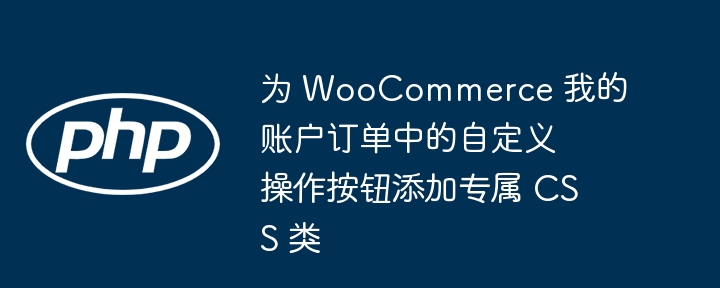
Add an exclusive CSS class to the custom action button in WooCommerce My Account Order
Article Introduction:This article describes how to apply a unique CSS style to the custom action buttons added to the order list on the WooCommerce My Account page. By using action alias as CSS class names, combined with CSS selectors, it is easy to customize the style of new buttons without affecting the existing styles of other buttons. In addition, a method is provided to modify the WooCommerce template file to remove the default CSS class for a specific button.
2025-08-13
comment 0
820

H5Next page instructions
Article Introduction:Adding next page instructions to the H5 page can guide users and enhance interactivity in their browsing experience. The implementation method includes: adding a div with "next page" text in HTML. Use CSS style to customize the appearance and position of the indicator. Detect page scrolling through JavaScript event and display or hide indicators accordingly. Sets the click event of the indicator to perform navigation operations such as jumping to a specific page or anchor, loading more content, etc.
2025-04-06
comment 0
579

How to create custom archive templates
Article Introduction:To customize WordPress archive page templates, 1. You need to understand the naming rules such as archive.php is a general archive page, category.php is used for categories, tag.php is used for tags, etc.; 2. Create or edit archive.php file and add titles, article loop structure and style; 3. Copy the general template for specific categories or tags and naming new files according to slug for customization; 4. You can create page templates with TemplateName annotations to achieve more flexible control, and customize the output content through WP_Query.
2025-08-15
comment 0
1009

How to style the active link in a navigation menu with HTML and CSS?
Article Introduction:To set the style of the current link in the navigation menu, the most direct way is to add a specific class name (such as class="active") to the link corresponding to the current page, and then define the style of the class in CSS; you can also automatically identify the current page and add the class name in a dynamic website through JavaScript to achieve a highlighting effect; at the same time, you should pay attention to path matching, style coordination and accessibility issues. The specific steps are as follows: 1. Manually add active classes to the current link in HTML; 2. Define .active styles in CSS; 3. Dynamic websites can automatically detect URLs through JavaScript and add active classes to matching links; 4. Pay attention to path parameter matching
2025-07-05
comment 0
847

Add a custom CSS class to WooCommerce My Account Order Action Button
Article Introduction:This article aims to guide WooCommerce developers how to add unique CSS classes to custom action buttons in the order list of the My Account page, enabling style customization for specific buttons and avoid affecting the default style of other buttons. The article will provide two methods: one is to style override the slug of the action button as the CSS class, and the other is to remove the default CSS class by modifying the WooCommerce template file, thereby achieving more granular control.
2025-08-13
comment 0
339

How to create a dark mode toggle with CSS
Article Introduction:The key to implementing dark mode switching on web pages lies in HTML structure, CSS style separation, JavaScript control class names and persistent storage. First, add button elements: toggle dark mode; second, define the body default style and .dark-mode class style in CSS; then, listen to the button click event with JavaScript and switch the class name: document.body.classList.toggle('dark-mode'); then, use localStorage to save user preferences, read the status when the page is loaded and restore the corresponding mode; finally, you can automatically detect system preferences and prioritize user storage settings. These steps allow for complete darkness
2025-07-19
comment 0
174
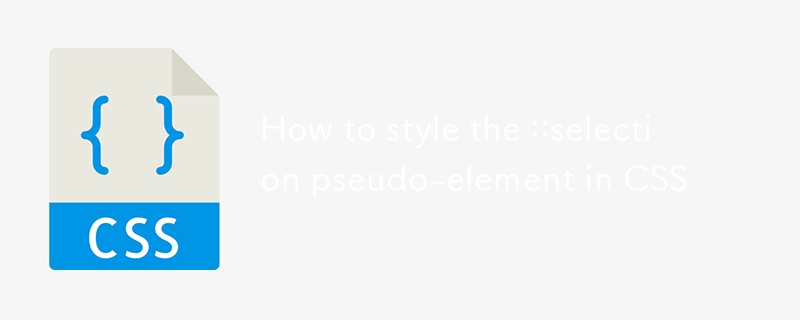
How to style the ::selection pseudo-element in CSS
Article Introduction:Use the ::selection pseudo-element to customize the style of text selected by the user on the web page. 1. You can set limited attributes such as background-color and color; 2. Modern browsers generally support standard syntax::selection, and old browsers can optionally add -webkit- or -moz-prefix; 3. It can be defined separately for specific elements such as a::selection or .class::selection; 4. Low contrast or too dazzling colors should be avoided to ensure readability and accessibility; 5. It is recommended to use a simple style such as a blue background with white text and slight shadows to enhance professionalism, and ultimately improve user experience without affecting usability.
2025-08-18
comment 0
339
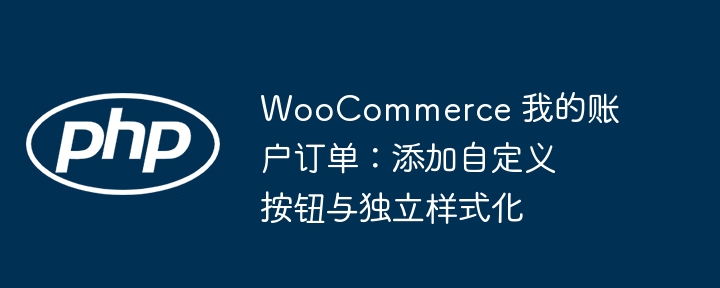
WooCommerce My Account Order: Add Custom Buttons with Independent Style
Article Introduction:This tutorial provides detailed instructions on how to add custom action buttons to WooCommerce's My Account order page and apply a standalone CSS style to it. The article first introduces how to add a button using the woocommerce_my_account_my_orders_actions filter and reveals how its $action_slug automatically becomes a CSS class, thus implementing specific style control. In addition, the tutorial also provides a way to achieve more advanced style customization by overwriting WooCommerce template files to meet more granular style needs and ensure the visual uniqueness of custom buttons.
2025-08-13
comment 0
997
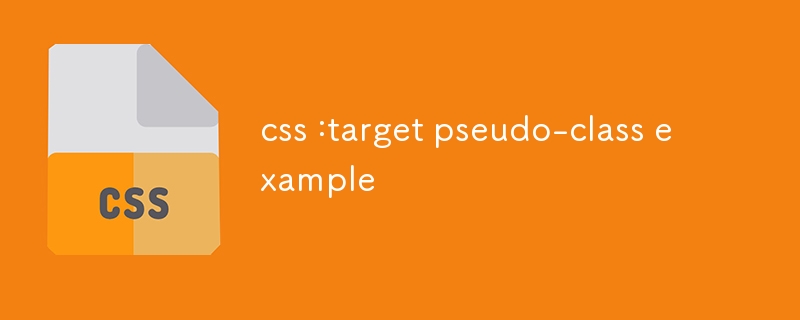
css :target pseudo-class example
Article Introduction::target pseudo-class is used to style elements pointed to by URL fragment identifiers. 1. When the link points to the ID in the page, the corresponding element becomes the target and applies a special style; 2. It can be used to highlight content, create tabs, or display/hide elements; 3. In the example, the target block is displayed and others are hidden through section:target; 4. The actual application includes FAQ, tab page and content highlighting; 5. Support animation enhancement effects without JavaScript; 6. Pay attention to ID uniqueness and only one element at a time is the target; 7. All modern browsers support this feature.
2025-07-28
comment 0
426

Bootstrap navbar fixed-bottom example
Article Introduction:Use the fixed-bottom class to implement a navigation bar fixed at the bottom, but you need to pay attention to content occlusion. The specific steps are as follows: 1. Add the navbarfixed-bottom class to the nav tag to fix the position; 2. To avoid the content being blocked, add margin-bottom (at least 56px) to the main body of the page; 3. You can combine the style to improve contrast or use JS to control the display logic.
2025-08-08
comment 0
808
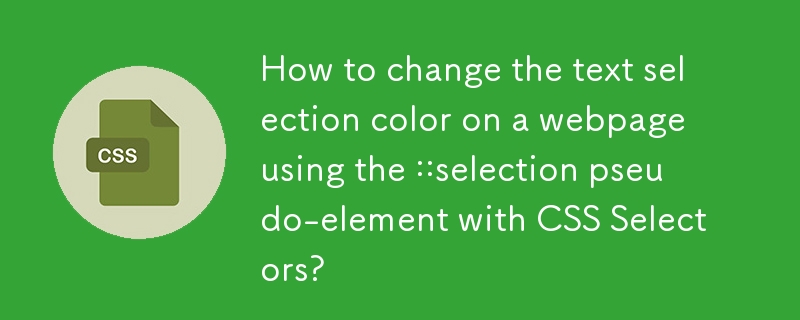
How to change the text selection color on a webpage using the ::selection pseudo-element with CSS Selectors?
Article Introduction:Want to customize the style of text selected by users on the web page? It can be implemented through the ::selection pseudo-element of CSS. ::selection allows setting some properties such as background color, font color, etc. of selected text, but does not support borders or gradient backgrounds. When using it, you can directly apply to specific tags or classes, such as p::selection or .highlight::selection. To ensure compatibility, it is recommended to add the -webkit- prefix to adapt to more devices. In addition, different selectors can be used to set different selection effects for various elements to improve the overall aesthetics of the page and user experience.
2025-07-04
comment 0
1036
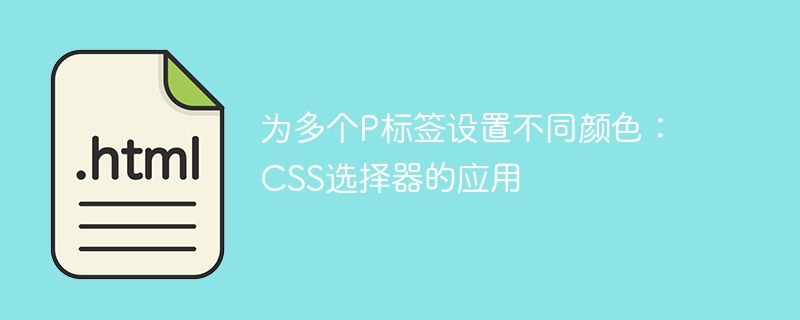
Set different colors for multiple P tags: Application of CSS selector
Article Introduction:This article introduces several ways to set different colors for multiple labels in CSS. It mainly includes using ID selectors, class selectors and inline styles. Through the example code, the implementation methods and applicable scenarios of each method are explained in detail, helping developers to flexibly use CSS selectors to realize personalized page style design.
2025-08-26
comment 0
188

How to disable Google Meet integration in Gmail on Chrome
Article Introduction:Gmail provides a GoogleMeet shortcut portal that can hide the left sidebar; 2. You can add filtering rules to block the page through browser extensions such as uBlockOrigin; 3. Use UserCSS style scripts to stably hide Meet elements. After opening Gmail settings, enter the "General" tab, check "Hide Meet Shortcut" and save to simply hide the sidebar entrance; for more thorough blocking, you can install ad blocking extensions and add custom CSS class name rules, or use Stylish class extensions to create user-style scripts to hide related elements in a targeted manner to achieve simplicity of the interface.
2025-07-13
comment 0
847

What is the difference between HTML id and class
Article Introduction:The id must be unique. One id in each page can only be used for one element, and the class can be reused on multiple elements, and one element can have multiple classes; 2. Scenarios using id include: positioning a single specific element, link anchors within the page, JavaScript operates elements through id, and labels associated with form elements; scenarios using class include: applying the same style or behavior to multiple elements, building reusable UI components, and selecting multiple elements in JavaScript; 3. In CSS, targeting is done by #id selector and .class selector respectively, getElementById() is used for id, getEleme
2025-08-07
comment 0
418
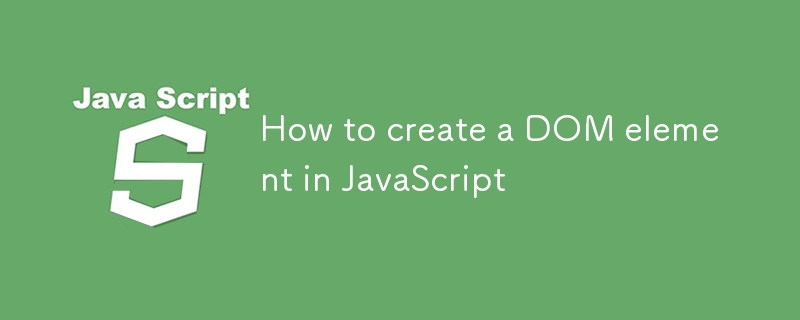
How to create a DOM element in JavaScript
Article Introduction:Use document.createElement() to create elements; 2. Modify content and attributes through textContent, setAttribute, etc.; 3. Add elements to the DOM using appendChild or append; 4. You can create and add multiple elements through a loop; 5. You can directly set style or add class class name; the core step of creating DOM elements is to create first and then modify and finally add to the page. This process is the basis and essential for implementing dynamic content.
2025-08-15
comment 0
832

How to style a var tag in CSS
Article Introduction:To effectively beautify the tag, first use the element selector to directly set the style, such as canceling the default italics, setting the monospace font, color and background; secondly, differentiated styles under different contexts can be achieved by adding class names; at the same time, semantics and accessibility must be maintained to avoid completely losing visual distinction; finally, in the code environment, the style can be adjusted in combination with the tag to enhance readability, ensuring that variables are presented clearly and consistently on the page.
2025-08-31
comment 0
780

What does do?
Article Introduction:It is a block container tag in HTML, used to wrap elements to implement layout and style control. As a block-level element, it occupies a single line by default, suitable for dividing web page structures, such as head, body and bottom; common uses include page layout, unified style settings, responsive design and JS operation target area; when used with CSS, styles are usually defined through class or id, such as .box setting width, margin and background color; unlike the latter, the latter is an inline element, and no line wrapping by default; when semantic labels are needed, the use of,, etc. should be given priority to improve readability and friendliness.
2025-07-30
comment 0
277

What is the :target pseudo-class and how can it be used?
Article Introduction:CSS's :target pseudo-class is used to style the target element based on the URL fragment identifier. It works by the browser scrolling to the element when the URL contains a # symbol and element id and allows a specific style to be applied to the element via :target. Common use cases include highlighting the page section after navigation, creating tabs or slideshows without JavaScript, and improving accessibility to long pages. Usage tips include ensuring that id is unique, combining transition or animation effects, switching content visibility with display attributes, and considering compatibility with older browsers.
2025-06-22
comment 0
756



















